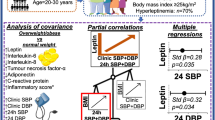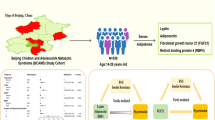Abstract
The aim was to clarify the associations of five adipocytokines: Sfrp5, Wnt5a, adiponectin, chemerin and high-sensitivity C-reactive protein (hsCRP) with blood pressure (BP), and to examine whether BP can be influenced by changes in these adipocytokines in obese children after a 6-month lifestyle intervention. We conducted a cross-sectional study in 263 obese children and performed a 6-month lifestyle intervention in a subgroup of 89 obese children with hypertension. Anthropometric data, adiponectin, chemerin, Sfrp5 and Wnt5a were assessed at baseline and after 6-month lifestyle intervention. Sfrp5 and adiponectin serum levels were significantly lower in obese children with hypertension, but Wnt5a, hsCRP and chemerin serum levels were elevated in obese children with hypertension. In multivariable linear regression analysis, Sfrp5, Wnt5a, adiponectin, chemerin and hsCRP were associated with both standard deviation score-systolic blood pressure (SDS-SBP) and -diastolic blood pressure (SDS-DBP). Lifestyle intervention resulted in a significant improvement in BP and weight loss. These were accompanied by significant decreases in hsCRP and chemerin, and significant increases in Sfrp5 and adiponectin, whereas Wnt5a was not changed. Furthermore, the changes in Sfrp5 and adiponectin act as partial mediators of the relationship between weight loss and BP reduction after controlling for covariates. Although Sfrp5, Wnt5a, adiponectin, chemerin and hsCRP levels are correlated with BP at baseline, after lifestyle intervention, the relationship between weight loss and BP reduction were partially mediated by changes in Sfrp5 and adiponectin after controlling for covariates. So we speculate that Sfrp5 and adiponectin may have some influence on BP.
This is a preview of subscription content, access via your institution
Access options
Subscribe to this journal
Receive 12 digital issues and online access to articles
$119.00 per year
only $9.92 per issue
Buy this article
- Purchase on Springer Link
- Instant access to full article PDF
Prices may be subject to local taxes which are calculated during checkout


Similar content being viewed by others
References
Wang Y, Lobstein T . Worldwide trends in childhood overweight and obesity. Int J Pediatr Obes 2006; 1: 11–25.
Babinska K, Kovacs L, Janko V, Dallos T, Feber J . Association between obesity and the severity of ambulatory hypertension in children and adolescents. J Am Soc Hypertens 2012; 6: 356–363.
Targher G, Day CP, Bonora E . Risk of cardiovascular disease in patients with nonalcoholic fatty liver disease. N Engl J Med 2010; 363: 1341–1350.
Reinehr T, Andler W . Changes in the atherogenic risk factor profile according to degree of weight loss. Arch Dis Child 2004; 89: 419–422.
Hvidt KN, Olsen MH, Ibsen H . Effect of changes in BMI and waist circumference on ambulatory blood pressure in obese children and adolescents. J Hypertens 2014; 32 (7): 1470–1477.
Gray L, Lee IM, Sesso HD, Batty GD . Blood pressure in early adulthood, hypertension in middle age, and future cardiovascular disease mortality: Hahs. J Am Coll Cardiol 2011; 58: 2396–2403.
MacDougald OA, Burant CF . The rapidly expanding family of adipokines. Cell Metab 2007; 6: 159–161.
Landgraf K, Friebe D, Ullrich T, Kratzsch J, Dittrich K, Herberth G et al. Chemerin as a mediator between obesity and vascular inflammation in children. J Clin Endocrinol Metab 2012; 97 (4): E556–E564.
Iwashima Y, Katsuya T, Ishikawa K, Ouchi N, Ohishi M, Sugimoto K et al. Hypoadiponectinemia is an independent risk factor for hypertension. Hypertension 2004; 43: 1318–1323.
Laudes M . Role of WNT signalling in the determination of human mesenchymal stem cells into preadipocytes. J Mol Endocrinol 2011; 46: R65–R72.
Lagathu C, Christodoulides C, Tan CY, Virtue S, Laudes M, Campbell M et al. Secreted frizzled-related protein 1 regulates adipose tissue expansion and isdysregulated in severe obesity. Int J Obes 2010; 34: 1695–1705.
Ouchi N, Higuchi A, Ohashi K, Oshima Y, Gokce N, Shibata R et al. Sfrp5 is an anti-inflammatory adipokine that modulates metabolic dysfunction in obesity. Science 2010; 329 (5990): 454–457.
Lagathu C, Christodoulides C, Virtue S, Cawthorn WP, Franzin C, Kimber W et al. Dact1, a nutritionally regulated preadipocyte gene, controls adipogenesis by coordinating the Wnt/beta-catenin signaling network. Diabetes 2009; 58: 609–169.
Hu W, Li L, Yang M, Luo X, Ran W, Liu D et al. Circulating Sfrp5 is a signature of obesity-related metabolic disorders and is regulated by glucose and liraglutide in humans. J Clin Endocrinol Metab 2012; 98: 290–298.
Li H, Ji C, Zong X, Zhang YQ . Body mass index growth curves for Chinese children and adolescents aged 0 to 18 years. Chin J Pediatr 2009; 47: 493–498.
Stergiou GS, Yiannes NG, Rarra VC . Validation of the Omron 705I Toscillometric device for home blood pressure measurement in children and adolescents: the Arsakion School Study. Blood Press Monit 2006; 11: 229–234.
National High Blood Pressure Education Program Working Group on High Blood Pressure in Children and Adolescents. The fourth report on the diagnosis, evaluation, and treatment of high blood pressure in children and adolescents. Pediatrics 2004; 114: 555–576.
Mi J, Wang T, Meng LH, Zhu GJ, Han SM, Zhong Y et al. Development of blood pressure reference standards for Chinese children. Chin J Evid Based Pediatr 2010; 5: 4–14.
Baron RM, Kenny DA . The moderator mediator variable distinction in social psychological research: conceptual, strategic, and statistical considerations. J Pers Soc Psychol 1986; 51: 1173–1182.
Sobel ME . Asymptotic confidence intervals for indirect effects in structural equation models. Sociol Methodol 1982; 13: 290–312.
Rosner B, Cook NR, Daniels S, Falkner B . Childhood blood pressure trends and risk factors for high blood pressure: the NHANES experience 1988–2008. Hypertension 2013; 62: 247–254.
Howe LD, Tilling K, Benfield L, Logue J, Sattar N, Ness AR et al. Changes in ponderal index and body mass index across childhood and their associations with fat mass and cardiovascular risk factors at age 15. PLoS ONE 2010; 5: e15186.
Friedemann C, Heneghan C, Mahtani K . Cardiovascular disease risk in healthy children and its association with body mass index: systematic review and meta-analysis. BMJ 2012; 345: e4759.
Watts K, Bell LM, Byrne SM, Jones TW, Davis EA . Waist circumference predicts cardiovascular risk in young Australian children. J Paediatr Child Health 2008; 44: 709–715.
Zhang X, Patel A, Horibe H . For the Asia Pacific Cohort Studies Collaboration. Cholesterol, coronary heart disease, and stroke in the AsiaPacific region. Int J Epidemiol 2003; 32: 563–572.
Heart Protection Study Collaborative Group. MRC/BHF Heart Protection Study of cholesterol lowering with simvastatin in 20536 high-risk individuals: a randomised placebo-controlled trial. Lancet 2002; 360: 7–22.
Szmitko PE, Wang CH, Weisel RD, Jeffries GA, Anderson TJ, Verma S . Biomarkers of vascular disease linking inflammation to endothelial activation. Part II. Circulation 2003; 108: 2041–2048.
Nguyen S, McCulloch C, Brakeman P, Portale A, Hsu CY . Being overweight modifies the association between cardiovascular risk factors and microalbuminuria in adolescents. Pediatrics 2008; 121: 37–45.
Sesso HD, Buring JE, Rifai N, Blake GJ, Gaziano JM, Ridker PM . C-reactive protein and the risk of developing hypertension. JAMA 2003; 290: 2945–2951.
Shatat IF, Freeman KD, Vuguin PM, Dimartino-Nardi JR, Flynn JT . Relationship between adiponectin and ambulatory blood pressure in obese adolescents. Pediatr Res 2009; 65: 691–695.
Lehrke M, Becker A, Greif M, Stark R, Laubender RP, von Ziegler F et al. Chemerin is associated with markers of inflammation and components of the metabolic syndrome but does not predict coronary atherosclerosis. Eur J Endocrinol 2009; 161: 339–344.
Carstensen M, Herder C, Kempf K, Erlund I, Martin S, Koenig W et al. Sfrp5 correlates with insulin resistance and oxidative stress. Eur J Clin Invest 2013; 43: 350–357.
Ehrlund A, Mejhert N, Lorente-Cebrian S, Astrom G, Dahlman I, Laurencikiene J et al. Characterization of the Wnt inhibitors secreted frizzled-related proteins (SFRPs) in human adipose tissue. J Clin Endocrinol Metab 2013; 98: E503–E508.
Marinou K, Christodoulides C, Antoniades C, Koutsilieris M . Wnt signaling in cardiovascular physiology. Trends Endocrinol Metab 2012; 23: 628–636.
Ashley FW, Kannel WB . Relationship to weight change in atherogenic traits: the Framingham study. J Chron Dis 1974; 27: 103–114.
Holm JC, Gamborg M, Neland M, Ward L, Gammeltoft S, Heitmann BL et al. Longitudinal changes in blood pressure during weight loss and regain of weight in obese boys and girls. J Hypertens 2012; 30: 368–374.
Pajunen P, Jousilahti P, Borodulin K, Harald K, Tuomilehto J, Salomaa V . Body fat measured by a near-infrared interactance device as a predictor of cardiovascular events: The FINRISK’92 cohort. Obesity 2011; 19: 848–852.
Acknowledgements
We thank Xiaodong Weng, Meizhen Zhang, Jing Li and Ming Li for their help. This work was supported by the Nature Science Foundation of China No. 81172689. The major research funding schemes of the Second Affiliated Hospital of Xi'an Jiaotong University No. YJ (ZDJH) 201303(3).n.
Author information
Authors and Affiliations
Corresponding author
Ethics declarations
Competing interests
The authors declare no conflict of interest.
Rights and permissions
About this article
Cite this article
Yin, C., Chu, H., Li, H. et al. Plasma Sfrp5 and adiponectin levels in relation to blood pressure among obese children. J Hum Hypertens 31, 284–291 (2017). https://doi.org/10.1038/jhh.2016.76
Received:
Revised:
Accepted:
Published:
Issue Date:
DOI: https://doi.org/10.1038/jhh.2016.76
This article is cited by
-
Elevated Serum SFRP5 Levels During Preeclampsia and Its Potential Association with Trophoblast Dysfunction via Wnt/β-Catenin Suppression
Reproductive Sciences (2022)
-
Link between chemerin, central obesity, and parameters of the Metabolic Syndrome: findings from a longitudinal study in obese children participating in a lifestyle intervention
International Journal of Obesity (2018)
-
Inverse associations between serum levels of secreted frizzled-related protein-5 (SFRP5) and multiple cardiometabolic risk factors: KORA F4 study
Cardiovascular Diabetology (2017)



